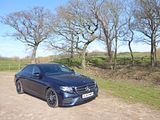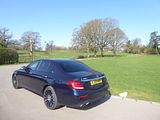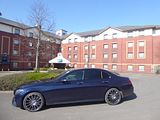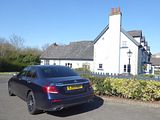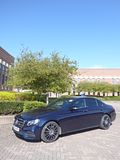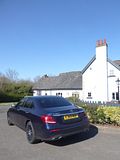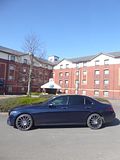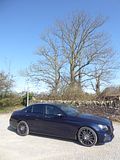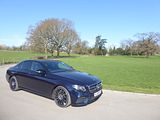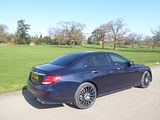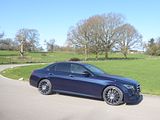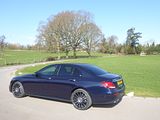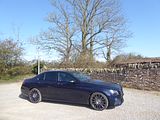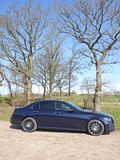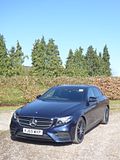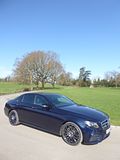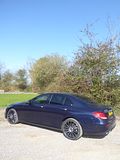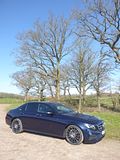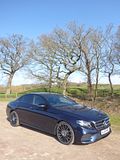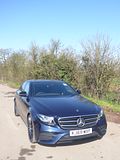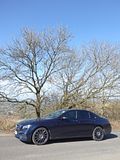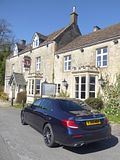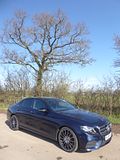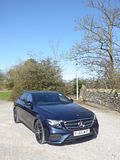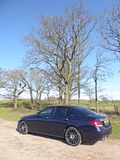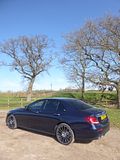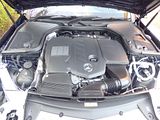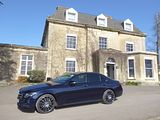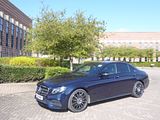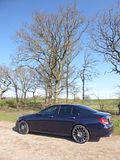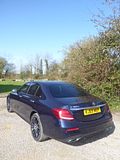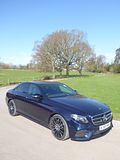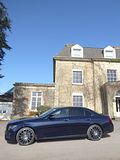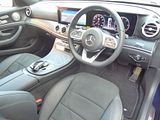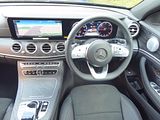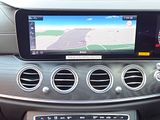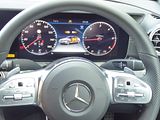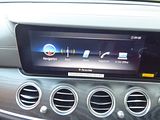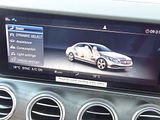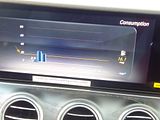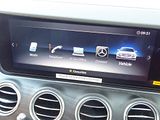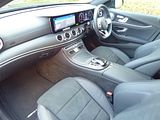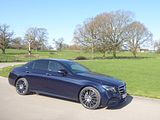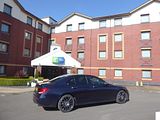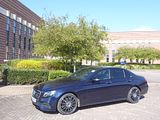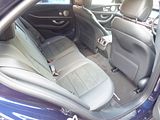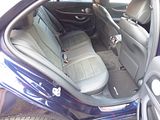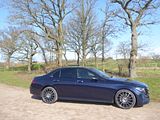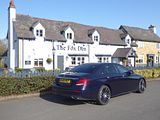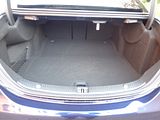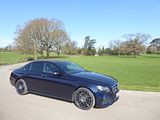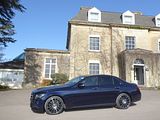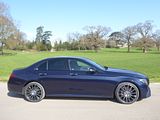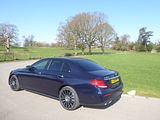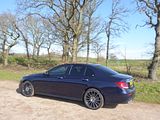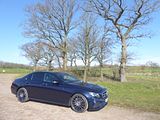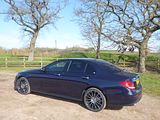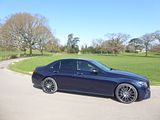Mercedes offer a vast, complex and sometimes seemingly over-lapping range of cars these days. Wind the clock back a bit and things were much simpler, where the core offering was a car that we now know as the E Class. That name was introduced in the mid 90s, with the mid-cycle update to the W124 generation car, as part of a new naming strategy which was needed when just using the engine size would no longer work given the number of different models with the same engine in them. The E Class’ predecessors go back much further than that, of course, with the seemingly indestructible W123 of the late 70s and early 80s, the “New Generation” W114/5 cars of the late 60s and early 70s and even the “Fintail” and “Ponton” cars before those. These were all cars that were very solidly built, and whilst somewhat austere (or plain meanly equipped, if you were feeling harsh but fair) which were bought as they represented true quality that would endure over many years, largely by people, let’s say, of an older generation. The addition of a popular estate model from the W123 generation added further appeal, and each successive E Class generation has sold in large quantities. As the twentieth century ran in to its final few years, though, it seemed that was not enough for Mercedes and they started to change things. For sure, the styling of each successive model has seen a fairly gradual evolution, but more and more kit and technology has been added, not initially entirely successfully, as the E210 model of 2002 developed an early reputation for electrical unreliability that was then matched with a propensity to rust which was quite a surprise to the loyal Mercedes owner who was not expecting these new attributes. Evidence of cost-cutting was all too apparent, as well. Whilst Mercedes has fixed the rust issue, their cars no longer have the reputation for indestructability that they once enjoyed and so the focus seems to be on trying to wow potential buyers with ever more tech. The current E class, the W213, was launched at the North American International Auto Show in Detroit in 2016, going on sale later in the year and faced an immediate problem that it looked all but identical to the C Class that sat below it in the range. Indeed, I recall talking to staff at the Geneva Moto Show and even they said they struggled to tell them apart (by the way, if you view the car side on, on the E Class the side crease line goes through the door handle line, whereas on the C Class it is well below them!). Four years in development, at a cost of over €1bn, these were the most advanced E Class ever, and Mercedes hoped that they could find new buyers as well as retaining the loyalty of their existing customers.
I got my first experience of this generation of E Class with a rather nice upgrade to an E450 Estate model from Hertz Switzerland in the spring of 2019 and was largely impressed by the combination of a lusty engine, lots of space and plenty of comfort, though I was not entirely convinced by the more glitzy features of the car, some of which stemmed from the fact that it was in AMG-Line trim. Chance to have another look at the W213 E Class came from Hertz at Heathrow when I was able to upgrade (this time paying real money) into a UK spec car, which, also in AMG Line trim, with its black wheels certainly looks a long way from those more austere E Classes of yore. I had the car booked for a week, but with growing rises in Covid infection rates was mindful of the fact that things might change, and indeed they did. Two days after collecting it, it was very apparent that I needed to get it back to Hertz rather promptly as all the rumours suggested the country was about to be locked down, and indeed that announcement came as I was travelling home having returned the car. So, whilst the test was not as long as I had been hoping for, I did manage to get some miles behind the wheel and take the accompanying photos. Here is what I made of the E300d AMG Line Premium Plus, to give the car its full name.
It’s been a long time since the numbers in a Mercedes model designation actually denoted the engine size and with constant changes of available engine and engine power, and indeed differences of name between different markets, I’ve now idea these days what engine actually powers the car and always have to look it up. E300d was not even familiar to me, as most diesel Mercedes cars, even in E Class form, seem to come badged as an E220d. Having done my research (and opened the bonnet and had a look!), I can tell you that an E300d does actually have a 3.0 litre engine, and there are 6 cylinders. It generates 242 bhp. Like most of the latest diesel engines, refinement is impressive and there are next to no aural clues to tell you what the prominent sticker on the fuel filler of a rental car does, that this needs to be filled up from the black pump. Even when starting from cold, this is a quiet engine and there is only occasional evidence of diesel-ness once underway. The E300d is very smooth and there is ample torque simply to waft you at increasing speed as the conditions require. There is a 9 speed auto box and with that many ratios, the upper ones are pretty close together but you will barely be aware that the transmission is moving between them. You can do so yourself, using the paddles, but I did not really see the point of doing so. At 70 mph, the engine is spinning at under 1500 rpm, so not surprisingly, there is not much noise to come from it at all, and with road and wind noise also well suppressed, this is a peaceful car in which to waft along a motorway. Despite the circumstances of the test, I was able to cover 420 miles in the car, and it needed just 40 litres when I was refilling it, rather eager to get home before that national lockdown kicked in. That works out at an impressive 47.67 mpg. The standard stop/start system will help with urban fuel economy, too, and it cut in and out as unobtrusively as any such system can these days.
In other driving respects, this E300d seemed very similar to the E450 Estate I had sampled in Switzerland just over a year previously. Despite that AMG badging and some of the design cues on the car, this is not a sports saloon, though it does trade some of the comfort for the illusion of sportiness. To blame here are no doubt the 275/30 R20 wheels and stiffer suspension than you would have expected from a “traditional” E Class. The ride is good on some surfaces, but proved that it cannot damp out some of the worst that UK roads has to offer. There are a number of driving modes you can select, which include Dynamic, Comfort and Sport, which do alter the suspension firmness a bit. The steering is light and a bit lifeless, though it does gain weight and feel the further away from dead centre you are. Most of my miles were done on the motorway, where handling and grip are not really tested much. More of a priority there can be the brakes and these proved fine, with good stopping distance form moderate pedal pressure. All round visibility is fine and here is where tech can help as there is an all-round camera which proved very useful when trying to park what is now a rather large car as tight into the kerb as possible, without imperilling those rather vulnerable alloys.
There have been a lot of press comments effusive in their praise of Mercedes interior design and quality in recent times, and yet, when I’ve actually sat in the car in question, I have to wonder if they based their comments on a picture as opposed to the real thing. The E Class is better than some of the less expensive models in the Mercedes range and certainly from a distance appears to blend quality with tech quite nicely, in a design that is pretty similar to that of the latest S Class. There is lots of leather and stitching and the selection of a matt wood for the inlays in the test car made it look less chintzy than some of the alternatives. But there are some elements that are just plain cheap and nasty such as the metal effect that so obviously is just horrid plastic that is on the steering wheel spokes, for instance. What you think of a dash design that comprises two 12.3 inch HD screens which look rather like two extended iPhones on their side may depend on your age, but it has become the Mercedes approach of late and is presumably cheaper to build than the traditional way of doing things. For sure the graphics are crisp and clear. There are two main dials, for speedometer and rev counter with smaller ones for fuel level and water temperature inset in the lower portion of the larger ones. These were not that easy to read quickly. The gear selector in on the right of the wheel, meaning that indicators and wipers are on the same stalk on the left, but at least this is where you expect and not lower down as used to be the case. Cruise control is now operated from the steering wheel spokes, where there are also some audio repeater functions. There are gear-shift paddles, so the area around the wheel does feel to get quite busy. Like many manufacturers, Mercedes have removed many of the buttons were found in the centre of the dash and put their functions into the touch screen, with all the usability issues that entail. I found the admittedly large touch screen to be fiddly to use, though the mouse clicker type unit in the centre console does help. The set-up includes a Burmester sound system but disappointing, whilst the sound was generally OK, the radio reception was not, with FM being particularly poor quality, not something you experience much these days. Lower in the central part of the dash are the buttons for the dual zone climate control. Plenty of them, but these, at least proved easy to use.
The seats appear to be upholstered in a combination of leather outers and an alcantara centre, but for some time now, Mercedes has been used what they call a “man-made” or artificial leather which the call Artico on all but the very highest of high-end models, and this is not one of those, so this is not real leather. But it looks convincing and does not appear to have the downside of the old “man made” coverings that we used to call vinyl. One Mercedes thing which has not changed is that the switches to move the seat about are all on the door, laid out in the form of the seat. The seat powers back when the ignition is turned off, to give more space between seat and wheel, making it even easier to get in and out, though in reality, there is no shortage of room here anyway. The seats on the test car had both heating and cooling features, neither of which I put to the test. The seats are large and comfortable and there is a feeling of spaciousness here, as you would expect from a large car. The steering column adjusts up/down and in/out, so making it possible for drivers of varying size able to find the position they want. The sunroof of the test car added some welcome light to the cabin and did not seem to take away any significant amount of headroom.
Space in the back of the E Class is generous. There is plenty of legroom even with the front seats set well back, and if they are at the front end of their travel, as I set them to suit my short legs, then there really is a lot of room indeed here. The backs of the front seats are moulded slightly to provide just that bit extra space. The central tunnel is quite wide and high but even so, there is ample room for a middle seat occupant here and no-one is likely to complain about available headroom, as there is plenty. There is a drop- down central armrest, with cup holders in the upper surface and the back of the console has air vents. The front seat backs have map pockets and there are some bins on the doors for odds and ends.
The boot is also very spacious. It is particularly long and uses all the width of the car to good effect. There is a bit more space under the floor as there is no spare wheel here but the well where one would go is usable for bits and pieces. The rear seat backrests are asymmetrically split and simply drop down to allow for the stowage of long loads. The boot lid has an electric close feature on it. Inside the passenger compartment, there is a modestly-sized glove box, bins on the doors, a couple of lidded cupholders and space under the central armrest for those odds and ends that always accumulate.
There’s a vast range of E Class models. As well as the saloon featured here, there are estate, coupe and convertible body styles on offer, each of which can be fitted with a wider variety of engines. These have changed over the model life of the W213 generation, as is the case for most cars these days, so keeping up is not easy. Initially the choices were pure petrol or pure diesel, with the range filling out in the months following launch. Petrol powered cars – with the name not really telling you the size of the engine – ranged from 4 cylinder E200 (181 bhp), E250 (208 bhp) and E300 (242 bhp) cars all using the same M274 2.0 turbo unit, to the 6 cylinder E350 and E450 models as well as the proper AMG monsters which started with an E43, later replaced by an E53 as well as the E63 and E63S. Diesel cars come as the E200d which puts out 150 bhp from a 1.8 litre engine, and the 2.0 litre engine E220d (191 bhp) and E300d (242 bhp) as well as 6 cylinder, with the initial E350d being replaced by an E400d. In late 2018 a diesel powered E300de with 194 bhp of combustion-produced power augmented by 122 bhp from an electric motor with a 34 mile range on pure electric, as well as a petrol E300e, with similar power and range were added to the list and quickly became popular, especially among company cars users for the benefit in kind advantages they have. As if that is not enough choice, the 4Matic all-wheel dive system is an option across most models in the range. Once the engine choice is made, then you need a trim, noting that not all trim levels are available with all the engines. Mercedes have concluded that people who want a more powerful engine will probably also want higher levels of equipment and also will want something that at least looks “sporty”, with the AMG-badged trims being more prevalent, though whether your traditional E Class buyer would go along with that is indeed questionable. The entry-level SE features blind spot assist; widescreen cockpit; four USB ports; touchpad with controller; illuminated door sills; spilt-folding rear seats; Parking package including Active Parking Assist with front and rear parking sensors; Seat Comfort package including Electro-pneumatic four-way lumbar support; ambient lighting with a choice of 64 colours; 18-inch five-spoke alloy wheels; Keyless-Go starting function; light carbon-grain aluminium trim with centre console in black open-pored ash wood; and heated front seats with electric adjustment. The AMG Line trim adds AMG exterior bodystyling, 18-inch five-twin-spoke alloy wheels, black open-pore ash wood trim with Artico Dinamica leather upholstery, AMG steering wheel with touch control buttons and privacy glass. The Premium package is available for £2,395 and includes COMAND Online, memory package, wireless charging, Multibeam LED; and Parking package including 360 camera. The £4,395 Premium Plus package adds to this with Burmester surround sound system, Keyless-Go package including hands-free access, automatic powered boot closing and keyless entry and a panoramic sunroof. For £595 the Night package (only available with AMG Line trim) can be added and includes 18-inch five-spoke alloy wheels in high-gloss black, diamond radiator grille and a single louvre in high-gloss black, front apron in high-gloss black, and rear bumper in high-gloss black with chrome trim. The Comfort package – only available in conjunction with the Premium or Premium Plus package – costs £1,895 for SE trim (£3,295 for AMG Line) and includes Air Balance; Energizing comfort control; Air Body Control air suspension; and Nappa leather upholstery (AMG Line only). Driver assistance systems include a Lane Tracking package (£595) that includes Active Lane Keeping Assist, and the more comprehensive Driving Assistance package (£1,695) which adds Active Brake Assist; Active Distance Assist DISTRONIC and Active Speed Limit Assist; Active Lane-change Assist; Evasive Steering Assist; Pre-Safe Impulse Side and Pre-Safe Plus. It is a very complex range and speccing one will not be a quick task.
There is much to like about this E Class. It has, so far, avoided straying too far in the direction that Mercedes seem to be heading where superficial glitz and chintz and an overload of generally superfluous technical gadgetry and gimmickry are seen as a higher priority than the real substance of the car, though there are some worrying signs even here in a car which is probably still bought by the more stereotypical Mercedes buyer than the new customers they are hoping to attract. The AMG styling features did not appeal to me, but that is down to personal taste and as with many cars you need to be sure that the largest wheels do not give you a ride quality that you can’t live with. Whilst diesel power may be seen as not just unfashionable but a motoring pariah, the unit in this car suits it well, as it is supremely smooth and refined and will deliver impressive levels of economy. And the car it sits in is also a decent place to be for potentially long stretches at a time. No wonder the E Class is popular for limousine taxi duty. Is it the best in class? That probably comes down to personal taste, with any BMW or Audi fan ready to tell you that their chosen brand has a “better” alternative and there are numerous other, slightly more left-field, options ranging from the Jaguar XF to Volvo S90 and even a Lexus GS or Genesis G80. Whilst I don’t think I would pick the Mercedes, I can see why so many people do and – provided none of that complex and expensive technology fails, which is, sadly by no means a given these days – would be happy with their choice.


